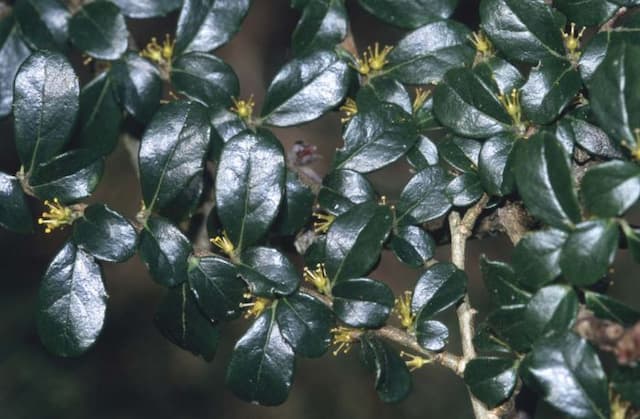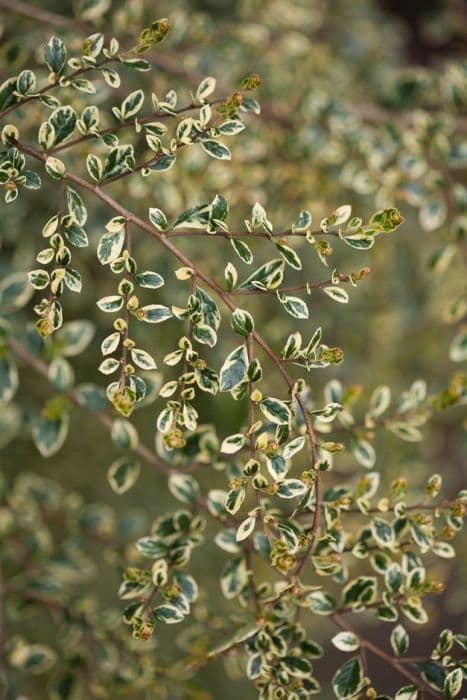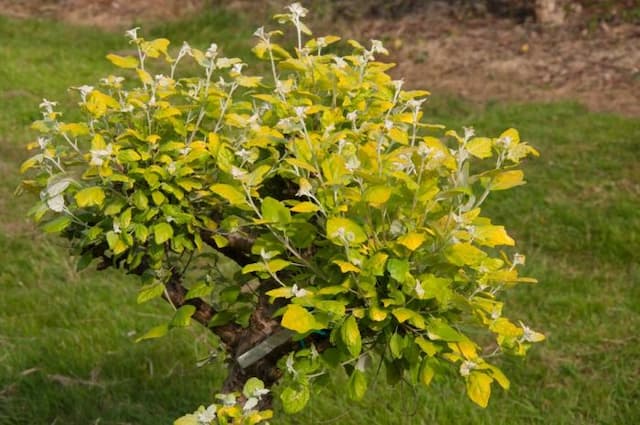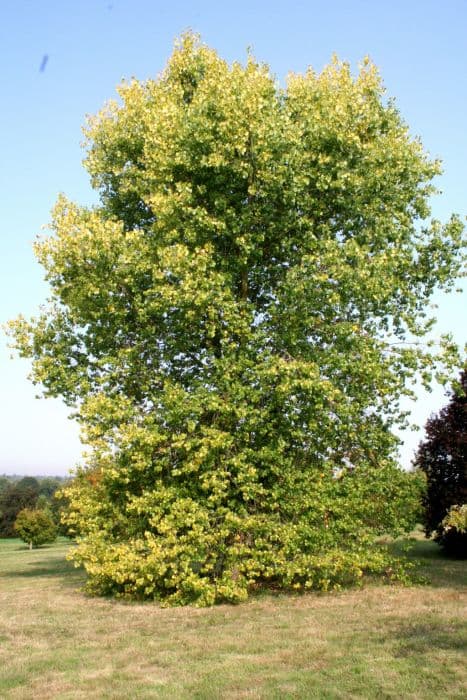Hooker's Willow Salix hookeriana

ABOUT
Salix hookeriana, commonly known as Hooker's willow, is a deciduous shrub recognized by its dense, bushy growth and its flexible, elongated branches. The bark of this plant can be observed as being brown to gray, showing texture with age. The leaves are one of its distinctive features, with their long, narrow shape and finely toothed edges, which may feel slightly sticky to the touch due to a thin, protective coating. The upper side of the foliage displays a lush green color, while the underside is paler, often with a bluish or grayish tint. During the blooming period, the Hooker's willow produces catkins, which are cylindrical flower clusters. These catkins—blooming before the plant fully leafs out—can be quite conspicuous with their fluffy, silken appearance, typically a yellowish or greenish hue depending on their maturity and sex, as the plant is dioecious with separate male and female flowers. As for the overall form of Hooker's willow, it has a rounded shape with a tendency to spread, which can provide a full, dense appearance with its foliage and branches arching gracefully. The leaves and the catkins together bestow a fine-textured look to the plant, especially when observed up close. The interplay of light through the leaves and the seasonal changes in appearance make Hooker's willow a dynamic presence in the landscapes where it naturally occurs or is cultivated for ornamental purposes.
About this plant
 Names
NamesFamily
Salicaceae
Synonyms
Hooker's Willow, Dune Willow, Coastal Willow
Common names
Salix amplifolia, Salix gooddingii, Salix lasiolepis var. hookeriana, Salix orestera, Salix sessilifolia Nutt.
 Toxicity
ToxicityTo humans
Hooker's willow (Salix hookeriana) is not commonly known to be toxic to humans. Generally, willows contain salicin, which is related to aspirin, and while it is not considered highly toxic, excessive ingestion could potentially cause discomfort or more serious symptoms related to salicylate poisoning, which may include nausea, vomiting, tinnitus (ringing in the ears), or diarrhea. As with most plants, individual sensitivities can vary, so it is advisable to avoid eating or ingesting parts of ornamental plants unless they are known to be safe for consumption.
To pets
Hooker's willow (Salix hookeriana) is generally considered non-toxic to pets such as dogs and cats. Similar to its effects in humans, plants in the Salix family contain salicin, but in usual amounts, it does not pose serious risks to pets. Nonetheless, individual animals might have sensitivities or allergic reactions, and consumption of large amounts could potentially lead to gastrointestinal upset or symptoms of salicylate overdose, which are similar to those in humans, including vomiting, diarrhea, and possibly more severe reactions in rare cases. It's always best to prevent pets from consuming plant material to avoid any potential issues.
 Characteristics
CharacteristicsLife cycle
Perennials
Foliage type
Deciduous
Color of leaves
Green
Flower color
Yellow
Height
13 feet (4 meters)
Spread
20 feet (6 meters)
Plant type
Shrub
Hardiness zones
7
Native area
North America
Benefits
 General Benefits
General Benefits- Coastal Stabilization: Salix hookeriana, commonly known as Hooker's Willow, has a robust root system that can help stabilize soil in coastal areas, reducing erosion.
- Wildlife Habitat: It serves as a habitat for various species of birds and insects, providing them with shelter and nesting sites.
- Streambank Stabilization: Its roots help to stabilize streambanks, preventing erosion and improving water quality by filtering runoff.
- Fodder: The leaves and twigs can be used as fodder for livestock, particularly in rural parts of its range.
- Ecosystem Support: It supports riparian ecosystems by providing a critical component in nutrient cycling and functioning of these environments.
- Landscaping: With its attractive form and foliage, it's used in landscaping for ornamental purposes or to create natural screens and windbreaks.
- Soil Improvement: The plant can improve soil quality over time through leaf litter decomposition, contributing to the organic content of the soil.
- Biodiversity: Hooker's Willow contributes to biodiversity by being part of complex food webs and offering resources for a variety of species.
- Carbon Sequestration: Like other trees, it captures and stores carbon dioxide, contributing to carbon sequestration and climate change mitigation.
 Medical Properties
Medical PropertiesThis plant is not used for medical purposes.
 Air-purifying Qualities
Air-purifying QualitiesThis plant is not specifically known for air purifying qualities.
 Other Uses
Other Uses- Salix hookeriana, commonly known as Hooker's Willow, can be used for basket weaving because the flexible branches can be woven into various shapes and patterns.
- The branches of Hooker's Willow are often used in the construction of living willow structures, such as arbors, due to their ability to root easily and grow when planted.
- Being tolerant to wet conditions, Hooker's Willow can be used in bioengineering practices for stabilizing streambanks and reducing soil erosion.
- The wood of Hooker's Willow is suitable for the production of charcoal, which can be used for drawing and other artistic applications.
- In landscaping, Hooker's Willow provides valuable habitat for birds and other wildlife, functioning as nesting sites and food sources.
- The young shoots and stems of Hooker's Willow can be used as a natural rooting hormone when planted alongside other cuttings due to the presence of auxins that promote root growth.
- Hooker's Willow is sometimes planted in water filtration systems known as constructed wetlands for the phytoremediation of contaminated water.
- The fibrous bark of Hooker's Willow can be processed and used in the creation of paper, offering an alternative to more conventional wood sources.
- Given its rapid growth, Hooker's Willow can be cultivated for biomass production that can potentially be converted into biofuels or other forms of renewable energy.
- As a natural dye, the bark of Hooker's Willow contains tannin which can be used to achieve a range of earthy tones on textiles and leathers.
Interesting Facts
 Feng Shui
Feng ShuiThe Hooker's Willow is not used in Feng Shui practice.
 Zodiac Sign Compitability
Zodiac Sign CompitabilityThe Hooker's Willow is not used in astrology practice.
 Plant Symbolism
Plant Symbolism- Flexibility and Resilience: Salix hookeriana, commonly known as Hooker's Willow, is known for its flexible branches which can bend without breaking, symbolizing the ability to adapt and withstand life's challenges.
- Growth and Renewal: As willows often grow near water and have a vigorous nature, Hooker's Willow represents new beginnings, growth, and renewal, akin to the perpetual renewal of life each spring.
- Healing: In various cultures, the willow has been associated with healing due to its salicylic acid-rich bark, which is used in pain-relieving medications like aspirin. This attribute of the willow can be extended to Hooker's Willow, representing healing and the soothing of pain.
- Freedom: The willowing branches that sway with the breeze can also symbolize freedom and the release of restrictive thoughts or emotions.
- Grief: Historically, willows are often found in cemeteries and their weeping form has been a symbol of mourning and grief. Hooker's Willow, as part of the willow family, can also represent sorrow and the expression of deep emotions.
 Water
WaterHooker's Willow prefers consistently moist soil and requires regular watering, especially during dry periods. You should water this plant deeply, allowing the water to soak into the soil, reaching down to the roots. An approximate guideline is to provide at least 1 to 2 gallons per week for a small tree; however, larger trees will require more water. Adjust the amount of water depending on rainfall, temperature, and soil conditions, ensuring that the soil does not become waterlogged, as this can lead to root rot. During the winter, reduce watering, but do not allow the soil to completely dry out.
 Light
LightHooker's Willow thrives in full sun to partial shade conditions. The ideal location would provide at least 6 hours of direct sunlight each day, but this plant can tolerate some light shade, especially in the hotter parts of the day. Avoid deep shade because it can lead to poor growth and fewer leaves.
 Temperature
TemperatureHooker's Willow is cold-hardy and can withstand a range of temperatures. It grows best in temperatures between 50°F and 75°F but can survive in temperatures as low as -30°F to -40°F. The ideal temperature conditions are moderate, avoiding extremes of heat or cold that can stress the plant.
 Pruning
PruningPruning Hooker's Willow should be done to remove dead or damaged branches and to maintain its shape. It’s best to prune during the dormant season, late winter or early spring, before new growth starts. Regular pruning every 2-3 years helps encourage new growth and maintain the health of the tree. Remove any suckers that arise from the base of the tree to prevent unwanted spreading.
 Cleaning
CleaningAs needed
 Soil
SoilThe Hooker's willow thrives best in moist, well-draining soil with a slightly acidic to neutral pH of 6.0 to 7.0. The ideal soil mix should include loamy soil, peat, and sand to maintain adequate moisture and allow for proper drainage.
 Repotting
RepottingHooker's willow generally does not require frequent repotting and can be done every 2 to 3 years. Since it's a large shrub, repotting might only be necessary if grown in a large container and when the plant becomes root-bound or the soil is exhausted.
 Humidity & Misting
Humidity & MistingHooker's willow prefers high humidity levels, similar to the natural humid conditions of riverbanks and wetlands where it naturally grows. However, it is adaptable and can tolerate a range of humidity levels as long as the soil moisture is adequate.
 Suitable locations
Suitable locationsIndoor
Ensure bright light, consistent moisture, and room to grow.
Outdoor
Plant in sun or partial shade with moist soil.
Hardiness zone
7-9 USDA
 Life cycle
Life cycleSalix hookeriana, commonly known as Hooker's Willow, begins its life cycle as a seed, typically dispersed by wind or water. Once settled in a suitable moist habitat, the seed germinates, and a young seedling emerges, rapidly growing into a juvenile plant. As the plant matures, it develops a robust root system and woody stems, entering the vegetative growth stage where it focuses on producing leaves and branches. The reproductive phase follows, with the willow producing catkins (flowers) that are either male or female, relying on wind pollination for fertilization. After successful pollination, seeds develop within capsules and, once mature, are released to start a new cycle. Throughout its life, the willow may also propagate vegetatively from cuttings or broken off twigs that root readily in wet soils, bypassing the seed stage.
 Propogation
PropogationPropogation time
Spring-Early Summer
The most popular method of propagation for the Hooker's willow, more widely known as Salix hookeriana, is through the use of hardwood cuttings. This process is typically undertaken in late fall to early winter, when the tree is dormant. Cuttings should be taken from mature, healthy branches and should be about 8 to 10 inches (20 to 25 centimeters) in length. The bottom end of the cutting is then dipped in rooting hormone to encourage root development and planted in a mixture of sand and peat moss to provide adequate drainage and moisture retention. The cuttings should be watered regularly and kept in a cool place until roots have developed, at which point they can be planted in their permanent location.









